Dialing in your gear, even something seemingly insignificant like hiking socks, is essential to getting the most out of your hike. A good hiking sock will cradle the natural anatomy of your foot, keep your feet dry, and, most importantly, keep blisters at bay. In other words, hiking socks provide the protection you wouldn’t get with your typical cotton socks.
However, with endless varieties of hiking socks to choose from, finding a pair that works for you can quickly become overwhelming. This guide will help you choose the best pair of hiking socks for your year-round adventures, along with our top hiking sock recommendations to keep you happy and comfortable on the trail all day.
Why The Right Sock Matters
Blisters are the bane of a hiker’s existence. Nothing sucks the fun out of an otherwise perfect hike than when you start to feel that familiar, localized pain on the back of your heel. Those new to hiking believe blisters just come with the territory, regardless of your experience level. We all have to deal with blisters from time to time, but they don’t have to be a constant nuisance.
The right pair of hiking socks will prevent blisters while providing ample support and comfort on the trail. Even the best hiking boots on the market won’t protect you from blisters if your socks aren’t up to snuff.
What to Consider When Choosing The Right Hiking Socks
Hotspots, blisters, rashes, wet feet, and cold toes are signs you’re wearing the wrong type of socks for your hiking adventures. But with a bit of knowledge, you can nip all of these problems in the bud. Consider the following when choosing your hiking socks.
Material
A sock’s material is the key to its breathability, warmth, and ability to keep you dry in wet weather. Hiking socks are generally made from a combination of the following materials.
Wool: Most hiking socks are made from a wool blend. Wool provides cushioning and helps regulate temperature to keep your feet from getting sweaty. Moreover, wool is naturally antimicrobial and does not retain odors like synthetic fabrics. Speaking of synthetic, many wool socks are blended with synthetic fibers to make them more durable and quick-drying.
Polyester/Polypropylene: Polyester or polypropylene is a synthetic material often blended with wool and/or nylon to create a combination of insulation, comfort, durability, and moisture-wicking properties for blister protection.
Silk: Silk is an effective thermal insulator that preserves the body’s natural heat, making it a popular material used in socks designed for cold-weather hiking.
Nylon: This is another synthetic option occasionally used as the primary material. Socks made from nylon are more durable and feature moisture-wicking properties to keep your feet dry for those rainy-day hikes.
Spandex/Elastane: This stretchy material helps socks retain their shape and prevent bunching and wrinkles, which can cause blisters. Most hiking socks contain small amounts of spandex or elastane.
Weight
Hiking socks are divided into four different categories based on sock thickness.
Ultra-lightweight: An ultra-lightweight sock is perfect for trail running and hiking in warm to hot weather. It aims for breathability and minimal padding, making it thinner than other socks.
Lightweight: This sock weight is ideal for warmer conditions and higher-intensity activities. Lightweight socks are also preferred for hiking, backpacking, or running in cool to warm weather. Winter hiking won’t be fun in these, as they aren’t adequately insulated.
Midweight: These socks feature more cushioning along the heel and forefoot to keep you comfortable during extended hikes or long-distance backpacking trips. Midweight socks are also thicker, providing more insulation in cold weather conditions.
Heavyweight: Heavyweight socks have thick padding to prioritize heat retention and comfort. This type of sock is perfect for winter hiking or for people who need extra support on the trail. Keep in mind thicker socks are less breathable and moisture-wicking than thinner ones. A liner is recommended if you’re prone to blisters.
Length
A sock’s height indicates how high it rises on your leg. The height of your socks will depend on the weather, terrain, and your choice of footwear. Crew socks are best paired with traditional hiking boots and provide more overall warmth and protection if you’re hiking through brush or tall grass. Ankle and no-show socks pair best with hiking shoes or trail runners. Shorter socks don’t offer the same protection and coverage as long socks and won’t work well with most hiking boots.
Fit
A brand’s sizing guides may save you from buying socks that don’t fit right. Pay special attention to how your heels and toes feel when trying on socks. Having too much material on either end could cause blisters and chafing. In contrast, a short sock will have you constantly reaching down to pull it back up while moving. When it comes to hiking socks for men or women, gender should have no bearing on a sock’s performance, durability, and comfort. However, women’s socks will usually feature a narrower profile and smaller heel pockets than men’s hiking socks.
Our Picks For The Best Hiking Socks
Best Overall Merino Wool Socks For Hiking
Stance Wool Hiking Socks
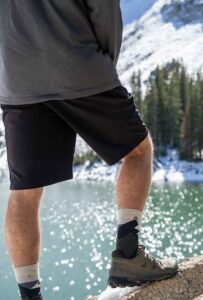 Fabric: 34% Merino Wool / 34% Polyester 29 % US Nylon / 3% Elastane
Fabric: 34% Merino Wool / 34% Polyester 29 % US Nylon / 3% Elastane
Why you’ll love it: Stance puts a guarantee for life Infiknit™ through reinforced toes and heels for longer lasting socks. They are extremely comfortable, durable, well designed, and they look pretty cool too!
Things to keep in mind: Stance has left and right socks – so just make sure you put them on the right feet.
Designed specifically for hiking, these socks are durable, comfortable, and look great. The fabric blend provides great moisture wicking, warmth, durability, and even odor control.
View On Stance | View On Amazon | View On REI
REI Co-op Merino Wool Lightweight Hiking Crew
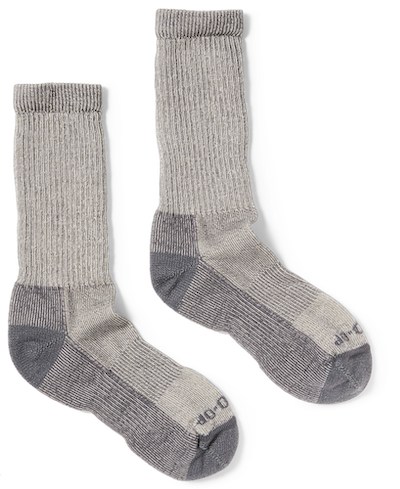
REI Co-op Merino Wool Lightweight Hiking Crew Socks
Fabric: 79% RWS merino wool / 20% nylon / 1% Lycra spandex
Why you’ll love it: Their breathable, anti-odor, quick-drying, and durable design make these merino wool socks perfect for 3-season adventures. These soft, durable socks are also cheaper than the leading name-brand alternatives, making them a great budget-friendly option for hikers just starting out.
Things to keep in mind: Light cushioning makes these socks unsuitable for cold weather hiking, and some people have complained of bunching, so take note of their size guide before buying.
You can almost always count on the REI Co-op for high-quality gear at an affordable price. And their hiking socks are no exception. The REI Co-op Merino Wool Lightweight Hiking Crew is a true workhorse. The 79% merino wool blend makes these socks perfect for summer adventures when you want decent cushioning and support. A seamless toebox prevents chaffing, while its padded heels, toes, footbeds, and Achilles deliver all-day comfort. These socks are also made in the USA using wool certified to the Responsible Wool Standard (RWS), so you can feel good about putting your money where your mouth is.
Best Lightweight Socks For Warm-Weather Hiking
Farm to Feet Damascus 1/4 Crew Light Targeted Cushion
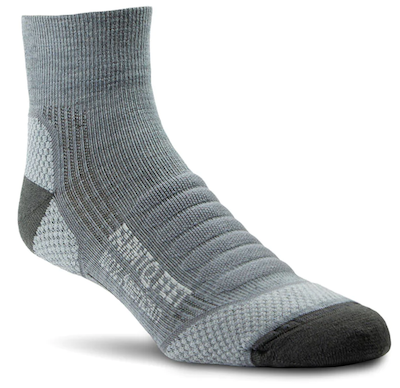 Fabric: 51% US Merino Wool / 45 % US Nylon / 4% US LYCRA® Spandex
Fabric: 51% US Merino Wool / 45 % US Nylon / 4% US LYCRA® Spandex
Why you’ll love it: Made in the USA with a generous lifetime guarantee, this high-quality sock is ready to go the distance with high-impact cushioning and unique ventilation features to keep your feet comfortable and dry.
Things to keep in mind: A bit more on the pricey side, with some complaining the brand’s size guide is a little wonky.
Farm to Feet’s Damascus Crew provides the perfect balance of breathability and cushioning for longer day hikes and extended backpacking trips. With a seamless toe area for minimizing friction and preventing blisters and extra padding in high-wear areas, the Damascus is ready for anything the trail throws at you. To sweeten the deal, Farm to Feet also offers a lifetime guarantee on its products. So, if the quality of your socks isn’t up to par or your favorite pair of hiking socks is showing signs of wear, Farm to Feet will replace your socks with a brand, spankin’ new pair.
View On Farm To Feet | View On Amazon
Best Sock For Winter Hiking
Darn Tough Hiker Boot Full-Cushion
 Fabric: 66% merino wool / 32% nylon / 2% Lycra spandex
Fabric: 66% merino wool / 32% nylon / 2% Lycra spandex
Why you’ll love it: Darn Tough’s signature quality and rugged build are funneled into this winter-specific design, not to mention their famous lifetime warranty.
Things to keep in mind: At $28 MSRP, this is another splurge buy, and hikers with narrow feet complained about painful bunching due to its wide fit.
Over the years, Darn Tough has gained a reputation as a premium, well-respected and beloved hiking sock brand, specializing in one thing and one thing only: quality merino wool socks backed by a lifetime guarantee. Their Hiker Boot Full-Cushion sock is a fan favorite. Its high merino wool content keeps your feet toasty during snowy alpine hikes, cold weather camping, and multi-day backpacking trips during shoulder season.
View On Amazon | View On REI | View On Darn Tough
Best Socks For Thru-Hikes
Darn Tough Light Hiker Micro Crew
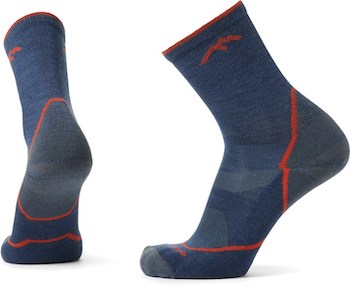 Fabric: 54% nylon / 43% merino wool / 3% Lycra spandex
Fabric: 54% nylon / 43% merino wool / 3% Lycra spandex
Why you’ll love it: With a lifetime guarantee, Darn Tough socks save you from surprise expenses on the trail.
Things to keep in mind: Not all Darn Tough retailers in trail towns honor that guarantee.
If you ask any thru-hiker what their favorite sock brand is, odds are they’ll say Darn Tough. While their lifetime warranty is a major draw for thru-hikers, who need a new pair of socks almost every month while on trail, their quality and construction set them apart from leading competitors in this space. Its micro crew height makes it ideal for hikers that prefer trail runners or low-cut boots, along with medium cushioning and support for covering big miles. What’s there not to love?
View Men’s On Darn Tough | View Women’s On Darn Tough | View On REI | View On Amazon
Fox River Medium Weight Wick Dry Euro Crew Sock
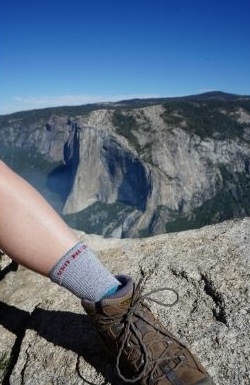
Fabric: 50% CoolMax® polyester / 25% cotton / 23% nylon / 2% spandex
Why you’ll love it: US Made, super high quality with 100% satisfaction guarantee.
Things to keep in mind: Fox River has various weights for just about every sock, allowing wearers to choose what’s best for the situation at hand.
There aren’t many sock manufacturers in the U.S. Fox River produces extremely high quality socks, but maintains prices that are still competitive with top sock brands. Quality design, with a variety of choices leaves hikers with ample options for any type of hiking.
Read our full review on Fox River Socks here.
View On Fox River | View All Women’s Hiking Socks | View All Men’s | View On Amazon
Best Hiking Sock Liner For Blister Prevention
Injinji Liner Crew Socks
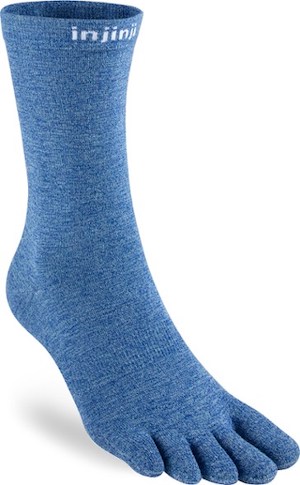 Fabric: 75% COOLMAX EcoMade polyester / 21% nylon / 4% Lycra spandex
Fabric: 75% COOLMAX EcoMade polyester / 21% nylon / 4% Lycra spandex
Why you’ll love it: People prone to blisters between their toes and on the balls of their feet describe Injinji liners as a game changer.
Things to keep in mind: Toe socks take a little longer to put on in the morning, especially with cold fingers and some people claim the craftsmanship and durability have gone down in recent years.
Injinji’s Liner Crew socks eliminate skin-to-skin contact with their individual toe slots. The liner’s COOLMAX polyester makeup provides an excellent combination of lightweight breathability and moisture-wicking properties. For those who suffer from blisters and hotspots regularly, Injinji’s liners could provide much-needed relief. Like most liners, their thinner materials lead to quicker wear and tear with extended amounts of use. So don’t expect it to last as long as a typical merino wool outer sock.
View On Injini | View On Amazon | View On REI
Hiking Sock FAQs
Should I Buy Waterproof Socks?
Waterproof footwear and socks are a big point of contention in the hiker community. Hardcore advocates swear by their pair of trusty Sealskinz to keep their feet dry on wet day hikes or rainy backpacking trips. On the other hand, detractors argue that waterproof socks lack breathability because of their Gortex membrane, resulting in blisters if worn for extended periods, the issue they were designed to prevent.
Waterproof socks will provide an extra layer of protection for half-day hiking trips when you’re likely to encounter multiple stream or river crossings or any amount of snow. For any other occasion, it’s safe to skip it and pack an extra pair of socks if your first gets wet.
Should I Buy Toe Socks?
Getting blisters between your toes is its own form of hell, and most hikers swear by toe socks to solve this problem. Toe socks separate the space between your toes, preventing rubbing that causes toe blisters. Additionally, the separation of your toes may improve your foot’s alignment. Because of this, toe socks can provide relief and support for people suffering from painful bunions. But other than that, toe socks are no more efficient than a typical hiking sock. In fact, some argue that adding two layers between the toes can significantly bulk up the toebox and make it too tight, increasing the risk of blisters on the side of your big and pinkie toes. Ultimately, the choice to wear toe socks will depend on your personal preferences.
Should I Double Up On Socks?
Many hikers favor a two-pair sock system which involves pairing a thin sock liner with a thicker outer wool sock. The basic idea here is that the sock liner minimizes friction and wicks moisture, while the outer sock traps that moisture and keeps your feet warm. Keep in mind, if you’re already prone to sweaty feet, layering on more material won’t help. Hot, sweaty feet are a recipe for blisters. Moreover, adding sock liners to the mix can cause your shoes to feel too tight, which can also lead to blisters.
How Do I Wash My Hiking Socks?
A pair of hiking socks can last for many years and trail miles if properly cared for. When washing socks made of merino wool or a wool blend, turn your socks inside out, machine wash on gentle cycle in warm or cool water, use a gentle soap, and either tumble dry on low heat or hang them out to air dry. Steer clear of bleach and fabric softener. Bleach can damage the merino wool fibers, and fabric softener hinders its ability to hold moisture and regulate temperature.
The Bottom Line
Choosing the best hiking socks comes down to considering your adventure needs, hiking footwear, and preferences around fabric blend, cushioning, length, fit, and style! You now have all the information you need to shop with confidence, in addition to some great hiking sock recommendations to help get you started. Your adventure awaits – get out there!

Ash Czarnota is a freelance writer based in Southern California with over 3,000 trail miles under her feet. She is the founder of Go Galavanting, an online community to celebrate adventurous women and highlight emerging thought leaders in the outdoor industry. A PCT alumni, Joshua Tree enthusiast and burgeoning climber, Ash uses her outdoor experiences to craft content that educates and inspires a rising generation of adventurers to embrace their inner wild. Connect with her on Instagram (@salty_millennial).
